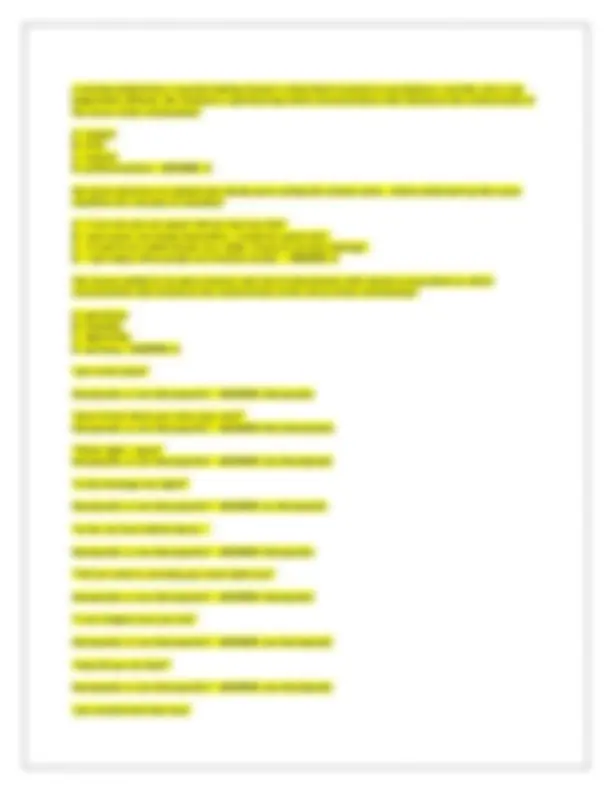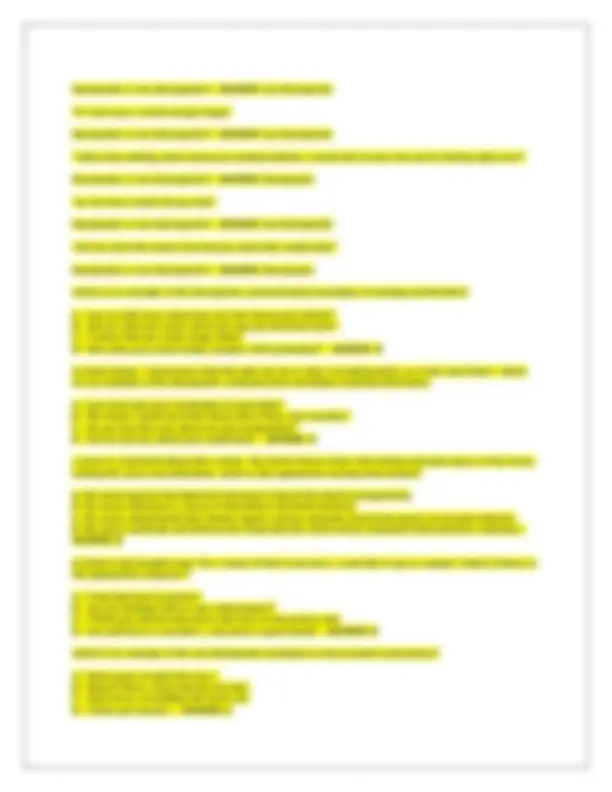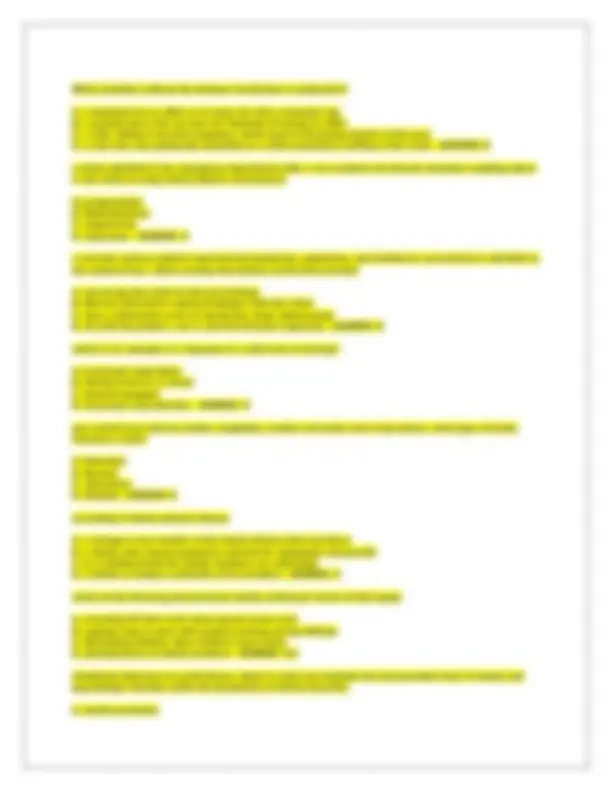





Study with the several resources on Docsity

Earn points by helping other students or get them with a premium plan


Prepare for your exams
Study with the several resources on Docsity

Earn points to download
Earn points by helping other students or get them with a premium plan
Community
Ask the community for help and clear up your study doubts
Discover the best universities in your country according to Docsity users
Free resources
Download our free guides on studying techniques, anxiety management strategies, and thesis advice from Docsity tutors
A series of practice questions related to nursing, focusing on critical thinking, the nursing process, and therapeutic communication techniques. It includes questions designed to test understanding of different phases of the nurse-client relationship, application of critical thinking in patient care, and the ability to differentiate between therapeutic and non-therapeutic communication. The questions cover topics such as assessment, diagnosis, implementation, and evaluation in nursing practice, offering a comprehensive review for nursing students preparing for exams. It also addresses the importance of empathy, genuineness, and trust in building effective nurse-client relationships, as well as defense mechanisms and anxiety management in patient care. This resource is valuable for reinforcing key concepts and enhancing exam readiness in nursing education.
Typology: Exams
1 / 7

This page cannot be seen from the preview
Don't miss anything!




NUR 201 Exam Practice Questions With Correct Detailed Answers. a patient developed a an infection after surgery and needs an IV for antibiotics, the RN receives an order to put in a PIV. the RN has no put in a PIV into a patient before. the RN reviews the procedure manual before carrying out the procedure. what level of critical thinking is this? A. basic critical thinking B. complex critical thinking C. nursing process D. scientific method - ANSWER- A. basic critical thinking John is completing an assessment of the patient and notices that she has a rash that he has never seen before. he reports the rash to the nurse and asks her to assess it with him. what type of critical thinking attitude is john applying A. humanity B. thinking independently C. curiosity D. responsibility and authority - ANSWER- D. responsibility and authority which of the following are objective and which are subjective? A. nausea B. Vomiting C. unsteady gait D. Anxiety E.bruises on the right arms and face F. temperature 101 'F - ANSWER- A. nausea - Subjective B. Vomiting - Both C. unsteady gait - Both D. Anxiety - Subjective E.bruises on the right arms and face - objective F. temperature 101 'F- objective the RN starts her data collection. what should she want to accomplish during the interview? Select all that apply a. establish a caring, therapeutic relationship with the patient b. determine the patients goals and expectations regarding their care c. gain insight about the patients worries d. determine the patients medical diagnosis e. obtain cues about which part of the interview may require further investigation f. conduct a review of systems - ANSWER- A,B,C,E,F which of the following statements are true about the nursing diagnosis? select all that apply A. nursing diagnosis are always based on a physiological problem B. Nursing diagnoses have two parts, the diagnostic label and related factor C. errors in nursing diagnosing can come from inadequate assesment D. Nursing diagnoses are focused on the scope or nursing practice - ANSWER- B,C, D a nursing student is getting ready to enter her clients room to do a comprehensive assessment. which one of the following statements is true of assessment? A. Assessment includes collection of data only B. assessment includes analyzing data to determine the need for nursing care C. assessment is centered on objective data
D. assessment is a separate activity from planning and implementing of care - ANSWER- B a nurse is preparing to do a focused assessment on a patient in her clinic. which of the following is true of what she is planing to do? A. pay close attention to the clients needs B. concentrate on an identified need and get more information C. identify a patients needs D. focus on all of the clients needs - ANSWER- B which of the following should be done by a nurse who is evaluating weather her clients newly diagnosed diabetes has reached his expected outcomes? A. the nurse should have a general idea about the clients plan of care B. the nurse should assess the client throughly and accurately C. The nurse should not be overly concerned with revising the care of plan D. the nurse should consult with the family but not the client about the expected outcomes - ANSWER- B when initiating the implementation phase of the nursing process, the RN preforms which of the following steps initially? A. carrying out nursing interventions B. Determining the need for assistance C. assessing the client D. documenting interventions E. delegating tasks to unlicensed assistive personnel - ANSWER- C "I dont know the answer right now, but i will find out in about an hour." this is an example of being honest with a client which is essential in: A. developing a trusting relationship with the client B. developing a friendship with the client C. helping the client with termination D. believing that you are a competent nurse - ANSWER- A which is the goal for the "orientation phase" of the nurse client relationship A. explore self - perceptions B. promote change C. establish trust D. evaluate goal attainment - ANSWER- C a client states, "i want to learn better ways to handle my anger." this interaction is most likely to occur in which phase of the nurse client relationship? A. pre-interaction phase B. Orientation phase C. working phase D. termination phase - ANSWER- B the nurse is attempting to establish a therapeutic relationship with an angry, depressed client. which is the most appropriate nursing intervention? A. work on establishing a friendship with the client B. use humor to defuse emotionally charged topics of discussion C.show respect that is not based on the clients behavior D. sympathize with the client when the client shares sad feelings - ANSWER- C
therapeutic or non therapeutic? - ANSWER- non therapeutic "if i were you, i would not get angry" therapeutic or non therapeutic? - ANSWER- non therapeutic "rather then talking about what your husband thinks, i would like to hear how you're feeling right now?" therapeutic or non therapeutic? - ANSWER- therapeutic "no one here would tell you that" therapeutic or non therapeutic? - ANSWER- non therapeutic "tell me what the doctor has told you about this medication" therapeutic or non therapeutic? - ANSWER- therapeutic which is an example of the therapeutic communication technique of seeking clarification? A. "can we talk more about how you feel about your father?" B. "tell me what you mean when you say you dont feel well?" C. "i notice that you seem angry today" D." How does your mood today compare with yesterday?" - ANSWER- B A client stated, "i dont know what the pills are for or why i am taking them, so i dont want them." which are an example of the therapeutic communication technique of giving information A. "you must take your medication to get better" B. "the doctor would prescribe these pills if they were harmful." C. "do you feel this way about all your medication?" D. "Let me tell you about your medication" - ANSWER- D a nurse is communicating with a client. the client moves closer and invades personal space of the nurse, making the nurse uncomfortable. which is the appropriate nursing intervention? A. the nurse ignores the behaviors because it shows the client is progressing B. the nurse expresses a sense of discomfort and limits behavior C. the nurse understands that clients require various amounts of personal space ad accepts behavior D. the nurse confronts and informs the client that the client will be secluded if this behavior continues - ANSWER- B A client in the hosptial says "Its a waste of time to be here, i cant talk to you or anyone" which of these is the appropriate response? A. "i find that hard to believe" B. "are you feelings that no one understands?" C. "i think you should calm down and look on the posiive side D. "our staff here is excellent , and youre in good hands" - ANSWER- B which is an example of the non therapeutic technique of unwarranted reassurance? A. "thats good. im glad that you.." B. "hang in there, every dog has his day" C. "dont worry, everything will work out" D. "i think you should.." - ANSWER- C
Which situation reflects the defense mechanism or projection? A. a husband has an affair so he buys his wife a diamond ring B. a promiscuous wife accuses her husband of having an affair C. a wife, failing to become pregnant, works hard at becoming teacher of the year D. a man who was physically assaulted as a child remembers nothing of the event - ANSWER- B a client admitted to the emergency department after a car accident, but doesnt remember anything about it. the client is using which defense mechanism? A.compensation B. Rationalization C. suppression D. repression - ANSWER- D a severely anxious patient experiencing headaches, palpations, and inability to concentrate is admitted to the medical floor. which nursing intervention would take priority? A. encourage the client to discuss feelings B. Discuss alternative coping strategies with the client C. have a distraction such as having the client attend group D. sit with the patient , use a calm but directive approach - ANSWER- D which is an example of a response to a mild level of anxiety? A. increased respirations B. feeling of horror or dread C. blocked thoughts D. increased concentration - ANSWER- D your client lives with his mother, stepfather, brother and sister and 2 step sisters. what type of family structure is this? A. Extended B. Nucelar C. alternative D. blended - ANSWER- D according to family systems theory: A. a change in one member of the family affects other members B. a family with closed boundaries allowed for adaptation and growth C. in a healthy family the family members are enmeshed D. a family is simply a collection of its members - ANSWER- A which of the following demonstrates family resiliency? check all that apply A. resuming full time work when spouse loses a job B. arguing ways to deal with problem solving among siblings C. Developing hobbies when children leave home D. placing blame on family members - ANSWER- A,C intentional behaviors to avoid illness, detect it early and maintain the best possible level of mental and psychiologic function within the boundaries of illness describe: A. health promotion
A. Focusing on the symptoms exhibited by the client. B. Identifying and validating unexpressed client needs. C. Permitting the client to set the pace for involvement in the interaction. D. Sharing appropriate ideas and feelings with the client. - ANSWER- A THE NURSE FINDS HIMSELF/HERSELF FEELING ANGRY WITH A CLIENT. THE NURSE SHOULD A. Tell the nurse manager to assign the client to another nurse. B. Suppress the angry feelings. C. Express the anger openly. D. Discuss the anger with a clinician during a supervision session. - ANSWER- D THE BIGGEST INHIBITOR TO GOOD COMMUNICATION IS: A. Failing to listen. B. Giving false reassurance. C. Disagreeing with the client. D. Passing judgment on the client. - ANSWER- A OPEN-ENDED QUESTIONS ARE ADVANTAGEOUS BECAUSE: A. They require less effort from the interviewee. B. They are less threatening. C. The interviewer controls the interaction. D. Reveals what interviewee feels is important. - ANSWER- D THE PATIENT, "I THINK I HAVE DIABETES. DO I?" WHICH RESPONSE BY THE NURSE WOULD BEST FACILITATE COMMUNICATION? A."Your lab tests are negative so far." B."Why do you think so?" C."I'm sure you are concerned. The doctor will tell you as soon as he knows" D. "What is it that makes you think you have diabetes?" - ANSWER- D THE RN'S PATIENT COMPLAINED WHEN HER 9 P.M. SNACK WAS NOT DELIVERED UNTIL 10:30 P.M. WHAT IS THE NURSE'S BEST RESPONSE? A. "You don't really need it anyway." B. "We are really busy tonight and I didn't have time for that" C. "You should have reminded me earlier." D. "I am sorry. Could I bring you something now?" - ANSWER- D WHICH OF THE FOLLOWING STATEMENTS IS THE BEST EXAMPLE OF AN EMPATHIC STATEMENT TOWARD A CLIENT? A."I will be glad to speak to the doctor for you." B."I can imagine how upset you must have been to do something like that." C."So what you're trying to say is that you couldn't think of any other options at the time." D."That is an example of how none of us get by with ignoring the rules." - ANSWER- B